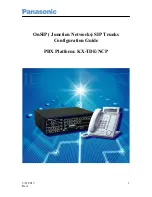
Page 56 of 64
Implementation and operation
553-2681-100 Standard 5.00 August 1996
17
Release the call.
18
Momentarily press the RLS key on the local-attendant console (or
multi-line). The associated LED goes out, and all calls requiring
attendant assistance are presented to the local attendant.
19
Proceed to the CAS Main attendant location, and conduct the tests in
Procedure 2.
Procedure 2
Testing the CAS feature at the CAS Main attendant
1
Verify that all CAS data is correct. See feature implementation.
2
Verify that the Release Link Trunks (RLT) are installed and enabled.
3
Verify that the TDS cards are installed and enabled.
4
Ensure that the CAS attendant console is equipped with the following:
—
an RLT X ICI key for each group of RLT from Remote locations,
where X designates a particular Remote location
—
a Signal Remote (SIG REM) key (above the LPK 5 key) and a
C/H key on the M1250 and M2250 consoles
—
a release destination (RLS DEST) key
5
From any telephone, dial the access code for a TIE trunk to a Remote
location. When the second dial tone (optional, depending on the route)
is heard, dial the DN for an RLT. This call is presented to the CAS
attendant. Ensure that the call is presented on the correct ICI key and
that the correct access code and route member number of the RLT are
displayed. When the CAS attendant answers, two 100-ms bursts of
440-Hz tone are heard by the attendant (if defined in customer LD 15)
before the voice path is established.
Calls that are active on a CAS attendant console and that are
presented to a Remote telephone (by means of RLT) are considered
as incoming external calls rather than as attendant calls for purposes
of digit display. This is done for the following reasons:
—
The identity of the CAS attendant cannot be determined from the
Remote end.
—
The display of the RLT identification is sufficient to indicate that
the call is connected to an attendant. The identification also
enables the user to identify the specific RLT used, in case of
a fault.
6
Repeat step 4 for each RLT at each Remote location.

























